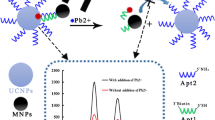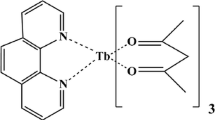Abstract
The authors report on a one-pot approach for synthesizing highly fluorescent protamine-stabilized gold nanoclusters. These are shown to be a viable nanoprobe for selective and sensitive fluorometric determination of lead(II) via quenching of fluorescence via Pb(II)-Au(I) interaction. Under optimized conditions, fluorescence measured at excitation/emission peaks of 300/599 nm drops in the 80 nM–15 μM lead(II) concentration range. The detection limit is 24 nM, and relative standard deviations (for n = 11) at concentrations of 0.10, 4.0 and 15 μM are 1.6, 2.5 and 1.9%, respectively. The relative recoveries of added lead(II) in the water samples ranged from 97.9 ± 2.29% to 101.2 ± 1.83%.

Lead(II) ions are found to be able to selectively and sensitively quench the fluorescence of the protamine-gold nanoclusters (PRT-AuNCs). Thereby, an inexpensive, selective and sensitive lead(II) assay was established.





Similar content being viewed by others
References
Liao H, Liu G, Liu Y, Li R, Fu W, Hu L (2017) Aggregation-induced accelerating peroxidase-like activity of gold nanoclusters and their applications for colorimetric Pb2+ detection. Chem Commun (Camb) 53:10160–10163
Lu L, Cheng H, Liu X, Xie J, Li Q, Zhou T (2015) Assessment of regional human health risks from lead contamination in Yunnan province, southwestern China. PLoS One 10:e0119562
Wang XF, Xiang LP, Wang YS, Xue JH, Zhu YF, Huang YQ, Chen SH, Tang X (2016) A “turn-on” fluorescence assay for lead(II) based on the suppression of the surface energy transfer between acridine orange and gold nanoparticles. Microchim Acta 183:1333–1339
Ebrahimi M, Raoof JB, Ojani R (2017) Design of a novel electrochemical biosensor based on intramolecular G-quadruplex DNA for selective determination of lead(II) ions. Anal Bioanal Chem 409:4729–4739
Zhang H, Wang S, Chen Z, Ge P, Jia R, Xiao E, Zeng W (2017) A turn-on fluorescent nanoprobe for lead(II) based on the aggregation of weakly associated gold(I)-glutathione nanoparticles. Microchim Acta 184:4209–4215
Shahdordizadeh M, Yazdian-Robati R, Ansari N, Ramezani M, Abnous K, Taghdisi SM (2018) An aptamer-based colorimetric lead(II) assay based on the use of gold nanoparticles modified with dsDNA and exonuclease I. Microchim Acta 185:151–156
Guo Y, Li J, Zhang X, Tang Y (2015) A sensitive biosensor with a DNAzyme for lead(II) detection based on fluorescence turn-on. Analyst 140:4642–4647
Tang S, Tong P, Li H, Tang J, Zhang L (2013) Ultrasensitive electrochemical detection of Pb2+ based on rolling circle amplification and quantum dots tagging. Biosens Bioelectron 42:608–611
Zhang D, Yin L, Meng Z, Yu A, Guo L, Wang H (2014) A sensitive fluorescence anisotropy method for detection of lead (II) ion by a G-quadruplex-inducible DNA aptamer. Anal Chim Acta 812:161–167
Talio MC, Zambrano K, Kaplan M, Acosta M, Gil RA, Luconi MO, Fernandez LP (2015) New solid surface fluorescence methodology for lead traces determination using rhodamine B as fluorophore and coacervation scheme: application to lead quantification in e-cigarette refill liquids. Talanta 143:315–319
Xu L, Shen X, Hong S, Wang J, Zhang Y, Wang H, Zhang J, Pei R (2015) Turn-on and label-free fluorescence detection of lead ions based on target-induced G-quadruplex formation. Chem Commun (Camb) 51:8165–8168
Xie J, Zheng Y, Ying JY (2009) Protein-directed synthesis of highly fluorescent gold nanoclusters. J Am Chem Soc 131:888–889
Tan Z, Xu H, Li G, Yang X, Choi MM (2015) Fluorescence quenching for chloramphenicol detection in milk based on protein-stabilized Au nanoclusters. Spectrochim Acta A Mol Biomol Spectrosc 149:615–620
Miao X, Cheng Z, Ma H, Li Z, Xue N, Wang P (2018) Label-free platform for microRNA detection based on the fluorescence quenching of positively charged gold nanoparticles to silver nanoclusters. Anal Chem 90:1098–1103
Peng J, Han CL, Ling J, Liu CJ, Ding ZT, Cao QE (2018) Selective fluorescence quenching of papain-Au nanoclusters by self-polymerization of dopamine. Luminescence 33:168–173
Jafari M, Tashkhourian J, Absalan G (2017) Chiral recognition of naproxen enantiomers based on fluorescence quenching of bovine serum albumin-stabilized gold nanoclusters. Spectrochim Acta A Mol Biomol Spectrosc 185:77–84
Lin YH, Tseng WL (2010) Ultrasensitive sensing of Hg2+ and CH3Hg+ based on the fluorescence quenching of lysozyme type VI-stabilized gold nanoclusters. Anal Chem 82:9194–9200
Deng HH, Wu GW, He D, Peng HP, Liu AL, Xia XH, Chen W (2015) Fenton reaction-mediated fluorescence quenching of N-acetyl-L-cysteine-protected gold nanoclusters: analytical applications of hydrogen peroxide, glucose, and catalase detection. Analyst 140:7650–7656
Wu YS, Huang FF, Lin YW (2013) Fluorescent detection of lead in environmental water and urine samples using enzyme mimics of catechin-synthesized Au nanoparticles. ACS Appl Mater Interfaces 5:1503–1509
Roque A, Ponte I, Suau P (2011) Secondary structure of protamine in sperm nuclei: an infrared spectroscopy study. BMC Struct Biol 11:14
DeLong RK, Akhtar U, Sallee M, Parker B, Barber S, Zhang J, Craig M, Garrad R, Hickey AJ, Engstrom E (2009) Characterization and performance of nucleic acid nanoparticles combined with protamine and gold. Biomaterials 30:6451–6459
Sivamani E, DeLong RK, Qu R (2009) Protamine-mediated DNA coating remarkably improves bombardment transformation efficiency in plant cells. Plant Cell Rep 28:213–221
Lien CW, Chen YC, Chang HT, Huang CC (2013) Logical regulation of the enzyme-like activity of gold nanoparticles by using heavy metal ions. Nanoscale 5:8227–8234
Zhao Q, Chen S, Zhang L, Huang H, Zeng Y, Liu F (2014) Multiplex sensor for detection of different metal ions based on on–off of fluorescent gold nanoclusters. Anal Chim Acta 852:236–243
Wang C, Wu J, Jiang K, Humphrey MG, Zhang C (2017) Stable Ag nanoclusters-based nano-sensors: rapid sonochemical synthesis and detecting Pb2+ in living cells. Sensors Actuators B Chem 238:1136–1143
Durgadas CV, Sharma CP, Sreenivasan K (2011) Fluorescent gold clusters as nanosensors for copper ions in live cells. Analyst 136:933–940
Hu YJ, Liu Y, Zhang LX, Zhao RM, Qu SS (2005) Studies of interaction between colchicine and bovine serum albumin by fluorescence quenching method. J Mol Struct 750:174–178
Zhu R, Zhou Y, Wang XL, Liang LP, Long YJ, Wang QL, Zhang HJ, Huang XX, Zheng HZ (2013) Detection of Hg2+ based on the selective inhibition of peroxidase mimetic activity of BSA-Au clusters. Talanta 117:127–132
Long YJ, Li YF, Liu Y, Zheng JJ, Tang J, Huang CZ (2011) Visual observation of the mercury-stimulated peroxidase mimetic activity of gold nanoparticles. Chem Commun 47:11939–11941
Zhang JQ, Wang YS, Xue JH, He Y, Yang HX, Liang J, Shi LF, Xiao XL (2012) A gold nanoparticles-modified aptamer beacon for urinary adenosine detection based on structure-switching/fluorescence-"turning on" mechanism. J Pharm Biomed Anal 70:362–368
Huai Q, Zhang B, Sheng F, Tao Z (1995) Raman and ATR infrared studies of the conformation of metallothionein in solution. Spectrosc Lett 28:829–838
Wu H, Liang J, Han H (2008) A novel method for the determination of Pb2+ based on the quenching of the fluorescence of CdTe quantum dots. Microchim Acta 161:81–86
Liu J, Lu Y (2003) A colorimetric lead biosensor using DNAzyme-directed assembly of gold nanoparticles. J Am Chem Soc 125:6642–6643
Chai F, Wang C, Wang T, Li L, Su Z (2010) Colorimetric detection of Pb2+ using glutathione functionalized gold nanoparticles. ACS Appl Mater Interfaces 2:1466–1470
Guo Y, Wang Z, Qu W, Shao H, Jiang X (2011) Colorimetric detection of mercury, lead and copper ions simultaneously using protein-functionalized gold nanoparticles. Biosens Bioelectron 26:4064–4069
Shi X, Gu W, Zhang C, Zhao L, Peng W, Xian Y (2015) A label-free colorimetric sensor for Pb2+ detection based on the acceleration of gold leaching by graphene oxide. Dalton T 44:4623–4629
Ding N, Cao Q, Zhao H, Yang Y, Zeng L, He Y, Xiang K, Wang G (2010) Colorimetric assay for determination of lead(II) based on its incorporation into gold nanoparticles during their synthesis. Sensors 10:11144–11155
Chen YY, Chang HT, Shiang YC, Hung YL, Chiang CK, Huang CC (2009) Colorimetric assay for lead ions based on the leaching of gold nanoparticles. Anal Chem 81:9433–9439
Hung YL, Hsiung TM, Chen YY, Huang CC (2010) A label-free colorimetric detection of lead ions by controlling the ligand shells of gold nanoparticles. Talanta 82:516–522
Acknowledgements
The authors gratefully acknowledge the support of the National Natural Science Foundation of China (No. 21177052), and the Science and Technology Program of Hunan Province in China (No. 2010SK3039).
Author information
Authors and Affiliations
Corresponding author
Ethics declarations
The author(s) declare that they have no competing interests.
Electronic supplementary material
ESM 1
(DOC 1.70 mb)
Rights and permissions
About this article
Cite this article
Huang, YQ., Yang, LN., Wang, YS. et al. Protamine-stabilized gold nanoclusters as a fluorescent nanoprobe for lead(II) via Pb(II)–Au(I) interaction. Microchim Acta 185, 483 (2018). https://doi.org/10.1007/s00604-018-3019-8
Received:
Accepted:
Published:
DOI: https://doi.org/10.1007/s00604-018-3019-8




